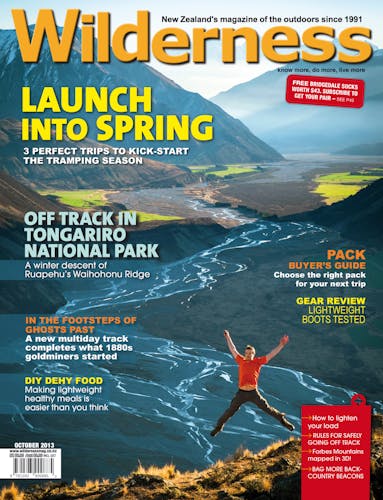Letter of the month: More tips for family adventures
Thanks for the family focus in the August 2013 issue. I really enjoyed the article ‘Through the ages’ for the glimpse it provided of what life may be like for us in the future. I am looking forward to the day my children can out-walk, out-paddle, and out-ski me, while at the same time reminding myself to enjoy the stage we’re at now.
We have four children between the ages of one and six years, and have found that, although we were adamant that having children would not interfere with our outdoor lifestyle, we have had to make some changes in the way we do things.
We still do the things we loved before we had kids, but everything is scaled back to a level that the whole family can enjoy. At this stage we love canoeing, mountain biking, day walks, fishing, camping and skiing. Our hope is that our kids will develop skills and a love of the outdoors that will hold them in good stead all their life.
Here are three things that help make our family outdoor adventures awesome:
1. Food is always a highlight and a powerful motivator, and we always ensure there are plenty of stops for snacks and treats.
2. We try to give the kids skills and ownership of the activities we do, like helping pitch the tent, setting the pace, route finding and deciding where and when to stop for snacks. My husband has also made two canoe paddles for our kids. I reckon these things help the kids go further, faster and be happier on our adventures.
3. Having adventures with other families has worked well for us. The kids have fun with their friends, the workload is reduced and it gives more options for doing different activities for different aged kids.
– Kath Tarr, email
Our letter of the month correspondent wins a Snackmaker Dehydrator worth $199 courtesy of www.hydraflow.co.nz. Send your letter to the editor for a chance to win.
Sun-confusion
Congratulations on an informative magazine. There is a puzzling aspect in the article ‘Hike to Hikurangi’ (Wild Trips, July 2013).
The writer notes that in the morning they ‘watched sun’s rays crawl up the slopes’. We have the same sun here at Kumeu, but its operation is quite different. Tops of hills are first lit followed by light proceeding down (in the evening sunlight retreats up the hills).
Are you or one of your readers able to explain this difference?
-Brian Cox, Kumeu
– Looks like we don’t know our sun-up from our sun-down. Brian is, of course, correct. -AH
Solitude is a volunteer project away
Looking for ways to escape to the wild and gain solitude in urban areas like Auckland (‘Editorial’, June 2013)? Why not try joining one or more of the groups looking after our native forests and their inhabitants. I, and many others, volunteer for the Ark in the Park group in the Waitakere Ranges Regional Park, killing introduced predators (boosting the numbers of birds already present) and returning bird species previously wiped out in the area.
I can assure you that you will get plenty of exercise, wild adventure, accomplishment and solitude doing a stint on a baitline. Plus, in the editor’s words, ‘it is also a real healer of the soul’ to help return the birdsong that belongs to these forests.
The other big plus is that it is cheaper than going to a gym and having to listen to that dreadful ‘music’ that they play!
– Mike Siddens, Auckland
Young poet says it all
My seven-year-old son Aidan wrote this poem recently at school after one of our now frequent visits to Catchpool Valley in Rimutaka Forest Park.
It made us feel like our efforts to get our boys out into the bush were not in vain.
Walking
My aim is to climb
the tallest tree
In the world!
But most of all
I would just love to walk
you can be with people
Staying in huts
Make new friends
Sit around a campfire
And toast marshmallows
Have fun
Be surrounded
By nature
Discover new plants
But most of all
It keeps you fit!
I’m not sure this qualifies as a letter to the editor but our entire family loves Wilderness and thought Aidan’s work would make a nice addition somewhere.
– Alastair Henshaw, email
– Aidan, you are a fine poet indeed – keep exploring the outdoors and especially when putting pen to paper! – AH
Doing more
I just wanted to drop a line to say how much I have appreciated the knowledge, advice, and experiences that make up Wilderness magazine. I’m fairly new to the outdoors, but it’s quickly become a passion for me and seeing the content of the magazine each month has inspired me to do things that I had previously never dreamed of doing.
The photographs and trail maps published turn to future plans for expeditions and encourage me to get fitter, learn more, and do more.
Thanks to each person who has contributed to the magazine. I look forward to the day I can start returning the favour.
– Gaylene Mulligan, email
– If, like Gaylene, you would like to share stories about your tramping trips, you can find our guidelines at www.wildernessmag.co.nz. – AH
Wear gear for the conditions
Over the last 10 or so years I have seen an increase in the use of down jackets in New Zealand. Generally, I think pulling on one of these in the shelter of a hut, tent or snow cave is a good idea (as they weigh little and are warm) and they look good in a Queenstown café or ski field. However, I have seen the down side of wearing these jackets on the track.
Down traps warm air and once wet clumps and goes flat, and takes days in the bush to dry out when saturated; even so-called waterproof down jackets get wet from condensation from the user as they sweat. The result? A cold, wet and miserable tramper.
I suggest saving the jacket for when you reach reliable shelter and wear traditional fleece and a proper rain jacket when and as New Zealand’s variable weather requires.
In Fiordland and Southland, where I now mostly tramp, rainfall is measured in metres. I have seen even the best down jackets turn to a soaking cold nylon bag of mush in just a couple of hours. I have left my down jacket at home when I tramp – if it does not go well in the wet it gets left hung in the wardrobe where such things belong.
And finally, a personal gripe: it is very hard to find an affordable full-length tramper’s rain coat long enough to keep shorts at least partly dry, and yet still allow for good movement on steep climbs!
– Brett Smith, Invercargill







